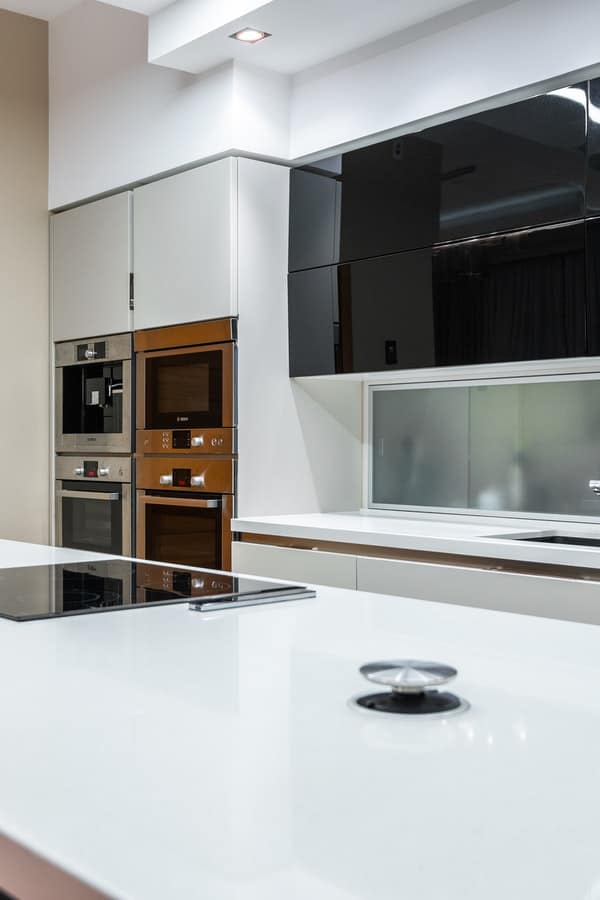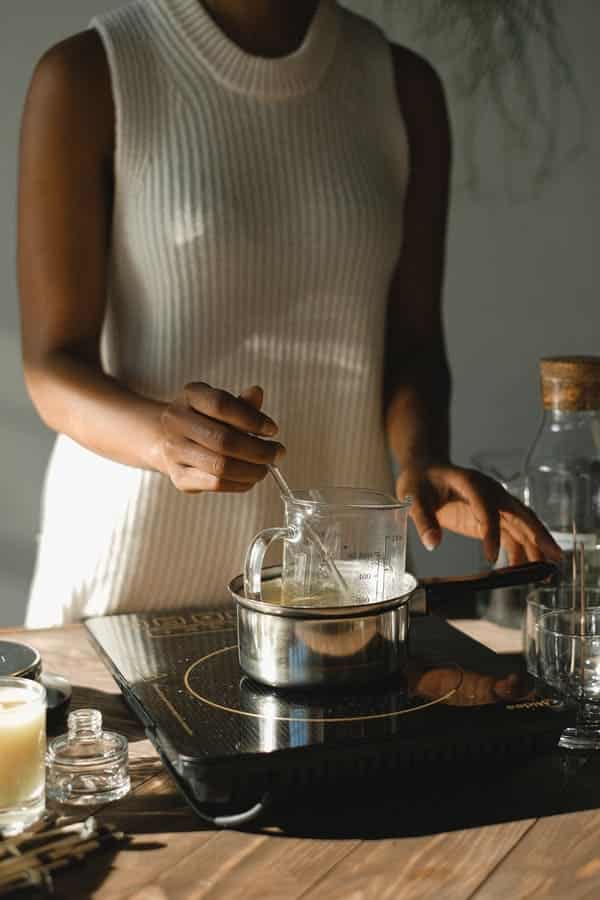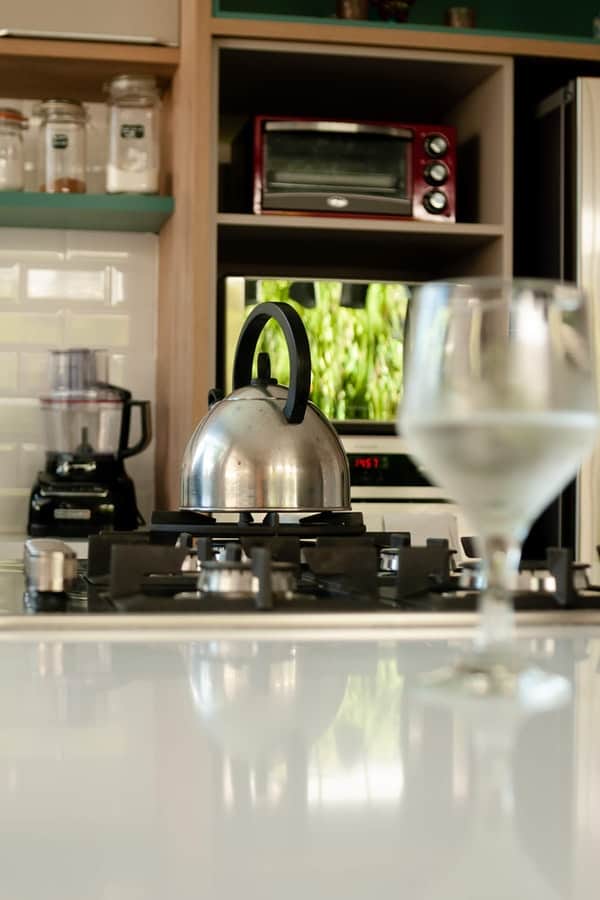Our stoves receive much action from daily use and sometimes heat, condensation, harsh cleaning products, and food residue can cause staining and a “cloudy” effect, which can often be tough to remove. This article shows you how to do so easily, and without needing to use harsh, expensive cleaning chemicals.
- What You’ll Need:
- Pre-Cleaning Your Glass-Top Stove
- What NOT to Use on Your Glass-Top Stove
- If Your Glass-Top Stove Haze isn’t Budging
- Other Methods
- What Causes Hazy Stove Tops?
- Glass Stove-Top Hazards
- Can Scratches be Removed from Ceramic Glass-Top Stoves?
- Removing Water Spots From Glass Top Stove
- General Tips for Glass-Top Maintenance
- How Long Do Ceramic Cooktop Stoves Last?
- Conclusion
There may be affiliate links in this article. You can read more about this in my disclosure.
What You’ll Need:
- Dish soap
- Rubber gloves & mask
- Clean dish towel/microfiber towel x 2
- Sponge
- Warm water
- White vinegar (for best results place the vinegar in a spray bottle)
- Baking soda
Pre-Cleaning Your Glass-Top Stove
Before you begin deep-cleaning the surface of the glass stove top, make sure that the surface is completely cool. If the stove top is hot, the cleaning products will evaporate, bubble, or burn onto the glass, and you run the risk of burning your skin.
Have clean and dry cloths at the ready to quickly wipe away cleaning products and water droplets that can leave streaks or residue marks on the glass. It’s wise to use old towels on your stove in case it is heavily soiled and may ruin the fabric.
To remove cloudiness or “haze” from your glass cooktop, coat the surface down with your white vinegar and cover the top with a generous sprinkling of baking soda.
Place a clean, damp towel (dampening your towel with hot water will help lift the staining) over the glass top and allow it to sit for up to 15 minutes (depending on how heavy the staining is).
Once the 15 minutes is up, rub away the baking soda with a soft sponge or damp towel and spray the surface with vinegar again. Rub out any streaks with a dry microfiber cloth.
Once these steps are complete, clean your glass-top stove with dish soap and warm water. Thoroughly dry with a clean, dry microfiber towel and polish as required.
Buff the stove top dry and repeat the process if necessary. To avoid extensive staining over time, daily maintenance will serve you well.
You can use plain water (and dish soap if you wish) onto the cool cooktop. Again, never clean a stove top while it is still hot.
What NOT to Use on Your Glass-Top Stove

While glass is a robust material, it is susceptible to damage if misused. This includes cleaning it with the wrong cleaning chemicals and materials.
In order to preserve the life and aesthetics of your glass-top stove, avoid using the following when cleaning it:
- Silver scourers/wire-wool products/bristled brushes. Rubbing this material on glass will cause scratches over time.
- Cleaning products that contain ammonia (even if they’re considered suitable for glass products, such as Windex). Ammonia can damage glass.
If Your Glass-Top Stove Haze isn’t Budging
Sometimes a bit of extra brute force is required for particularly stubborn cloud marks, so don’t be disheartened if you need to repeat the above cleaning process several times until your cooktop looks as good as new.
However, If you can’t remove the cloudy stains from your cooktop, it may have been scratched by rough scrubbers or discolored by commercial cleaning chemicals beyond repair. A black glass-top stove with discoloration that hasn’t budged after cleaning via the above method may be beyond salvation and subsequently may need to be replaced.
While many stains can be stubborn, resist the urge to put too much pressure on the glass stove top when cleaning in your attempt to remove a tough stain or haze. If you apply too much pressure on the glass to remove a layer of stubborn haze, you run the risk of cracking or scratching the glass, which will then need to be replaced.
Easy does it!
Other Methods
You can also clean your black glass-top stove and make it sans haze using citric acid. Citric acid, such as freshly-squeezed lemon juice acts as a natural bleach. And because it is heavily acidic, it is a very good natural substance for removing tough stains – and it will leave your kitchen smelling like summer!
[amazon box=”B07Q4R8W2D” template=”vertical”]What Causes Hazy Stove Tops?
Most of the stains on your glass cooktop are caused by food, cleaning chemicals, or calcium and magnesium minerals from hard water.
Pots and pans that are placed on the top fresh from the dishwasher may have a wet bottom, and if a pan is wet on the bottom, this will cause cloudy ring marks that aren’t always easy to wipe off.
Food spillages or water overboiling onto a hot burner is another common cause of cloudiness. Heat and liquid on glass will always cause staining.
Other causes of ceramic glass stove top discoloration include sliding your panware around on the stovetop and food remnants on the bottoms of pots and pans that melt onto the hot glass.
If your glass is scratched from cleaning or rough pan usage, food or liquids can get into the tiny crevices and make the glass very difficult to remove. Glass stove tops need to be treated carefully in order to preserve their longevity.
Glass Stove-Top Hazards

If you wish to keep your glass stovetop sturdy, well-maintained, and looking sparkly, there are a few things to avoid, or that need to be handled with care:
Pots and Pans
Cookware such as dutch ovens, frying pans, etc, are typically made from strong materials such as stainless steel or cast iron, therefore if they are handled roughly whilst in use, or dragged across the stove top, you will eventually wear away the glass. Items such as pans will also crack a glass cooktop if they are dropped or roughly placed on the hob, so care needs to be taken when cooking.
Overboiling
It’s easy to forget about a pan and it overboiling – especially if your cooktop is induction. If the water in your area is hard, it will be heavy in minerals such as calcium and magnesium, which when heated in water that then meets a hot surface, can cause white limescale stains.
A good way to avoid pasta water boiling over is to place a wooden spoon across the surface of the pot. If you do experience a boil over or other spill, clean up the spills as soon as possible once the burner has cooled a little. Never let them sit too long.
Heavy Objects
Glass cooktops are only designed to withstand up to 50 lbs, so heavy items (or using the surface to stand on while dusting cobwebs from the ceiling!) will likely cause your top to crack.
Utensils
Avoid leaving cooking utensils, such as tongs or spatulas, on a warm cooktop while you cook. Liquid and food on these utensils can stain or burn onto the ceramic surface.
If this happens, clean it quickly and thoroughly and store your utensils elsewhere. If your utensils are wooden or plastic, this can also pose a fire threat.
Bad Habits
Always avoid bad habits stemming from laziness, such as using your glass stovetop as a chopping board to cut food! Sharp knives will scratch the glass surface and damage it.
It will also dull its look and make it hard to achieve the once-shiny look it had.
Can Scratches be Removed from Ceramic Glass-Top Stoves?

Yes and no. Regular buffing and avoiding harsh treatment will prevent scratches from building up.
If you regularly use the above cleaning method to deep-clean your glass-top stove, you should be able to avoid issues with scratches, as the baking soda will get into the fine cracks and fill them.
If this doesn’t work, or the scratches on the glass are large or deep, seek advice from your stove manufacturer. They may have certain recommendations for home remedies, or they may advise you to replace the cooktop.
Removing Water Spots From Glass Top Stove
If your location is prone to hard water, you may have a tougher time removing any water marks from your glass stove. Luckily, this is where your trusty baking powder comes in handy – again!
Below is a step-by-step guide on how to remove stubborn water marks from your hob.
- Step one: sprinkle baking soda over the stovetop.
- Step two: soak a soft cloth in a mixture of dish soap and hot water and place it over the area with water spots.
- Step three: wait 15 minutes before cleaning the surface in circular buffing motions.
- Step 4: afterward, shine the surface using a soft cloth/microfiber towel.
- Step 5: repeat if necessary.
General Tips for Glass-Top Maintenance
- Make it an everyday practice to clean the glass with water or vinegar, or at least weekly.
- Do not let any ash or food debris build up under the glass.
- Wipe down with a damp sponge or cloth after every use and towel-dry.
- Consider the manufacturer’s instructions for cleaning and maintenance.
- Burning Petroleum Coke (otherwise known as Petcoke) is harmful to a stove glass top, so avoid it. Other chemicals to also avoid are those with high sulphur content in them. As mentioned above, ammonia-based products should be avoided too.
- The best cleaning products are often homemade ones using items like lemon juice, vinegar, and/or baking powder. They are also cheaper and less harmful than harsh store-bought chemicals.
How Long Do Ceramic Cooktop Stoves Last?

While glass is a strong material, when faced with regular heat, fluids, and collision with other products, such as cast iron pans, they will eventually begin to erode.
However, if well-looked-after your glass-top stove can be expected to last 14 years or more with regular maintenance. Insurance can make the replacing of a damaged or cracked stovetop a less costly endeavour.
Conclusion
So, we have learned that the most effective way to remove haze or cloud marks from your glass stove is by using products you’ll already have in your kitchen, such as dish soap, baking powder, and white vinegar.
Regular cleaning and maintenance will preserve the lifespan of your stove top, and avoiding certain practices, such as applying wire-wool cleaning items or scraping or dragging heavy cookware items, such as cast iron, will prevent it from scratching.
If you look after your glass-top stove, it will last up to 14 year or more. Avoiding harsh chemicals that contain substances like ammonia will help preserve this longevity; as will cleaning after every use.



